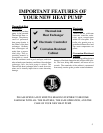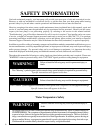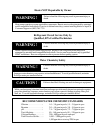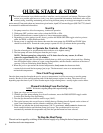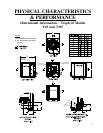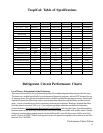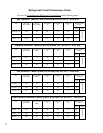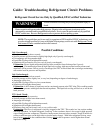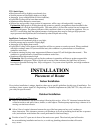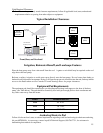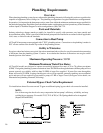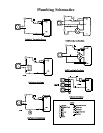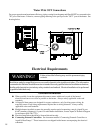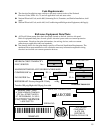
13
NOTE: These guidelines are for use only by experienced, EPA certified, HVAC technicians, and
were developed specifically for use with AquaCal heat pumps, and for use with Refrigerant Circuit
Performance Charts contained earlier in this manual.
Possible Conditions:
Unit Overcharged:
• Head pressure will be above normal;
• Suction pressure will be normal or slightly high (high, only if grossly overcharged);
• Unit amperage will be somewhat high;
• Liquid Sub-Cooling will be higher than normal;
• Superheat will be normal to low (low, only if grossly overcharged).
Explanation: Excess liquid refrigerant backs up in the condenser (into discharge line if grossly
overcharged). Elevated head pressure & high liquid sub-cooling, with near-normal suction pressure and
superheat, will be present. Unless grossly overcharged, the TXV will hold back the overcharge, maintaining
near normal suction pressure and superheat.
Unit Undercharged:
• Head pressure will be below normal;
• Suction pressure will be slightly low, to very low (depending on degree of undercharge);
• Amperage will be low;
• Liquid Sub-Cooling will be very low or nonexistent;
• Superheat will be higher than normal.
Explanation: A full column of liquid may not be consistently present at the TXV inlet. This condition results
in low suction pressure with higher than normal superheat. The liquid sub-cooling will be low, as will be the
head pressure.
TXV Stuck Closed:
• Head pressure will be excessive;
• Suction pressure will be lower than normal;
• Amperage will be high;
• Liquid Sub-Cooling will be higher than normal;
• Superheat will be higher than normal;
• Distributor lines may be frosted, iced, or very cold to touch.
Explanation: The flow of refrigerant is (mostly) stopped at the TXV. This results in a low suction reading
with high superheat. As liquid refrigerant “backs up” in the condenser, there is less room for high-pressure
vapor coming from the compressor. Therefore, head pressure increases above normal (TropiCal models do
not have sufficient space on the high-side to store the entire charge). With little refrigerant flowing, more
heat is being removed in the condenser than is being added at the evaporator- result: higher than normal
liquid sub-cooling.
Guide: Troubleshooting Refrigerant Circuit Problems
Refrigerant Circuit Service Only by Qualified, EPA Certified Technician
WARNING !
Failure to heed the following may result in permanent injury or
death.
Heater contains refrigerant under high pressure. Repairs to the refrigerant circuit must not be
attempted by untrained and/or unqualified individuals. Service must be performed only by qualified
HVAC technicians. Recover Refrigerant to relieve pressure before opening system.



